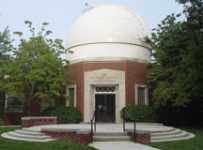Dyer Observatory
 Situated in a secluded area just to the Southwest of downtown Nashville, the Arthur J. Dyer Observatory was built in 1953 under the watchful eye of Vanderbilt University astronomy professor, Dr. Carl Seyfert. The main mission of Dyer Observatory is to provide both school children and the general public a place where they are introduced to the wonders of astronomy and space exploration.
Situated in a secluded area just to the Southwest of downtown Nashville, the Arthur J. Dyer Observatory was built in 1953 under the watchful eye of Vanderbilt University astronomy professor, Dr. Carl Seyfert. The main mission of Dyer Observatory is to provide both school children and the general public a place where they are introduced to the wonders of astronomy and space exploration.
ACCRE
 The Advanced Computing Center for Research and Education (ACCRE) is built and operated by Vanderbilt faculty, and is used by investigators in a wide and growing spectrum of research disciplines. Researchers in such diverse fields as astrophysics, biophysics, biostatistics, human genetics, manufacturing supply networks, nanoscience, neuroscience, microelectronics, particle physics, proteomics, and structural biology are using ACCRE resources. The high-performace computing center includes about 4000 CPUs with a 10 Gb/s intake capability (a new record).
The Advanced Computing Center for Research and Education (ACCRE) is built and operated by Vanderbilt faculty, and is used by investigators in a wide and growing spectrum of research disciplines. Researchers in such diverse fields as astrophysics, biophysics, biostatistics, human genetics, manufacturing supply networks, nanoscience, neuroscience, microelectronics, particle physics, proteomics, and structural biology are using ACCRE resources. The high-performace computing center includes about 4000 CPUs with a 10 Gb/s intake capability (a new record).
SDSS-III

Building on the legacy of the Sloan Digital Sky Survey (SDSS), the SDSS-III Collaboration will carry out a program on three scientific themes: (i) Dark energy and cosmological parameters, (ii) The structure, dynamics, and chemical evolution of the Milky Way, and (iii) The architecture of exoplanetary systems. From 2008-2014, SDSS-III is exploiting the unique wide-field spectroscopic capability of Apache Point Observatory’s 2.5-meter telescope.
LSST

The 8.4-meter Large Synoptic Survey Telescope (LSST) will survey the entire visible sky deeply in multiple colors every week with its three-billion pixel digital camera, probing the mysteries of Dark Matter and Dark Energy, and opening a movie-like window on objects that change or move rapidly: exploding supernovae, potentially hazardous near-Earth asteroids, and distant Kuiper Belt Objects. The LSST will provide unprecedented 3-dimensional maps of the mass distribution in the Universe, in addition to the traditional images of luminous stars and galaxies.
